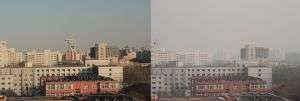What leaves the citizens of Beijing breathless

This week's smog alarm at Beijing underlines the relevance of air pollution in the Chinese capital. Researchers of Karlsruhe Institute of Technology (KIT) have been studying factors influencing air quality in the megacity for ten years now. The Environmental Mineralogy and Environmental Systems Analysis Working Group headed by Professor Stefan Norra analyzes the development of fine dust pollution among others. A few days ago, the Chinese partners under the direction of Professor Kuang Cen of the China University of Geosciences organized a symposium on this topic in Beijing.
Poor visibility, people wearing breathing masks, driving bans, closed factories and construction sites: This week, China's capital Beijing for the first time imposed the highest smog alert level. The megacity is covered by a gray umbrella of smog. Smog is a strongly increased concentration of air pollutants. It occurs above densely populated areas under certain meteorological conditions and has been a problem in Chinese megacities for many years now. Fine dust particles of a few micrometers in size may penetrate deep into the lungs. From there, they enter blood vessels, where they may cause inflammation. Possible consequences are irritations of mucous membranes and respiratory tracts, cardiovascular diseases, and even cancer.
The Environmental Mineralogy and Environmental Systems Analysis Working Group headed by Professor Stefan Norra of KIT has been studying air quality in Beijing since 2005 already. The researchers analyze long-term development of dust pollution, interactions between natural and anthropogenic particles as well as the impacts of types of urban uses on air pollution. The working group consists of employees of the Institute of Applied Geosciences (AWG) and the Institute of Geography and Geoecology (IfGG) of KIT.
Recently, Professor Stefan Norra and Dr. Nina Jasmin Schleicher, KIT, in cooperation with scientists from Bordeaux and Beijing, investigated temporal and spatial distributions and sources of particulate mercury (HgP) in the air above Beijing. Mercury may be harmful to man and the environment. "According to our measurements, mercury concentrations at Beijing are alarmingly high, especially in the heating period," geoecologist Stefan Norra says. Concentrations were found to be highest in winter in the inner city inside of the 3rd ring road. Coal combustion was determined to be the main source of mercury emissions. In addition, industry, transport and, to a smaller extent, the red color of historic buildings cause mercury emissions. "Due to its high toxicity, mercury in the air should be in the focus of future observation activities and mitigation measures," Norra explains.
The 2008 Olympics in Beijing showed the success of measures to reduce atmospheric particulate pollution. At that time, only half as many vehicles than usual were allowed to drive in the city and the surrounding provinces, restaurants with coal stoves were required to use soot filters, the production of heavy industry was partly stopped. Every day, Stefan Norra and his team took samples of particles in the air and analyzed their mass and chemical composition. The measures were indeed found to reduce dust pollution, but only as long as they were effective. After the Olympics, air pollution increased rapidly again.
Some days ago, concentrations of highly health-damaging PM 2.5 fine dust (particles of 2.5 µm and less in diameter) increased to more than 600 µg per cubic meter, more than 24 times the limit value given by the World Health Organization. Industry, transport, and private households in particular are responsible for fine dust pollution. In addition to anthropogenic particles, geogenic dust is transported to Beijing from arid regions by natural processes. Especially in spring months, this type of dust reaches high concentrations due to so-called dust storms.
Apart from continuous measurements over years at different daytimes and locations, the scientists also studied vertical distribution of dust pollution in cooperation with colleagues of the Atmospheric Environmental Research Division of KIT's Institute of Meteorology and Climate Research and the Institute of Regional Science of KIT. The COSMO-ART program developed by Dr. Heike Vogel and Dr. Bernhard Vogel of the Troposphere Research Division of KIT's Institute of Meteorology and Climate Research was applied to model spreading of the particles in the atmosphere. An important goal of the Beijing project is the development of methods to forecast fine dust pollution for the next days.
More information: N.J. Schleicher et al. Atmospheric particulate mercury in the megacity Beijing: Spatio-temporal variations and source apportionment, Atmospheric Environment (2015). DOI: 10.1016/j.atmosenv.2015.03.018
Journal information: Atmospheric Environment
Provided by Karlsruhe Institute of Technology



















